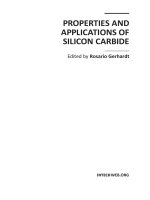Electrochemical properties and applications of conducting polymers in corrosion science
Bạn đang xem bản rút gọn của tài liệu. Xem và tải ngay bản đầy đủ của tài liệu tại đây (8.31 MB, 170 trang )
ELECTROCHEMICAL PROPERTIES AND
APPLICATIONS
OF CONDUCTING POLYMERS IN CORROSION
SCIENCE
TAN CHEAK KHAN, WILLY
(B.Sc. (Hons), NUS)
A THESIS SUBMITTED
FOR THE DEGREE OF DOCTOR OF PHILOSCOPY
DEPARTMENT OF MATERIALS SCIENCE
NATIONAL UNIVERSITY OF SINGAPORE
2003
Acknowledgements
i
ACKNOWLEDGEMENTS
First and foremost, I would like to thank my supervisor, Dr. Daniel John Blackwood,
whose extensive knowledge, generous guidance and inexhaustible patience proved
invaluable to the successful completion of this thesis, the expansion of knowledge on this
subject, as well as improvement of my researching skills.
Secondly, I would like to extend my heartfelt appreciation to the various people in the
different laboratories for their invaluable advice on the usage of various techniques and
equipment, which contributed to this thesis. Many thanks to:
• Mr Chan, Miss Agnes Lim and Auntie Karen for their much appreciated assistance
in the Materials Science Laboratory.
• Mr Tan and his staff for their ready assistance in the Physic Workshop.
• Postgraduate students from Functional Polymer, Department of Chemistry.
My sincere appreciation to my family whose love and encouragement gave me the extra
incentives to go beyond myself. To my classmates and friends whose kind support made
things less formidable, I am most indebted. Last but not least, I would like to thanks Mr
Christopher Lim for his much-appreciated concern, encouragement and help throughout
this project.
Table of Contents
ii
TABLE OF CONTENTS
ACKNOWLEDGEMENTS i
TABLE OF CONTENTS ii
STATEMENT OF RESEARCH PROBLEM vi
SUMMARY viii
LIST OF TABLE ix
LIST OF FIGURES AND ILLUSTRATIONS x
LIST OF SYMBOLS AND ABBREVIATIONS xiv
LIST OF PUBLICATIONS xv
1. INTRODUCTION 1
1.1 Introduction 2
1.2 Objectives 4
2. THEORY AND LITERATURE REVIEWS 5
2.1 Mechanism of Lacy Cover Formation in Pitting 6
2.2 Structure of the Passive film 8
2.3 Thickness of Passive film 9
2.4 The Passive Electronic Barrier 9
2.5 Critical Pitting and Repassivation Potential 10
2.6 Theory of Controlled Current Methods 11
2.6.1 Applying Semi-infinite Linear Diffusion on a Planar Electrode
in Solution 11
2.6.2 Constant Current Method- The Sand Equation 12
2.6.3 Applying Semi-infinite Linear Diffusion on a Planar Electrode
in the Case of Corrosion 12
2.7 Derivation of a Model for the Passivation of Metals under
Constant Current Regime 13
2.8 What are Conducting Polymers? 17
2.8.1 Polyaniline 17
2.8.2 Polypyrrole 18
2.8.3 CORRPASSIV from the company ORMECON 19
2.9 Corrosion Protection by Organic Coatings 20
2.9.1 Primers 22
2.9.2 Driving Forces behind the Development of Conducting Polymers
Coatings 22
2.10 Conducting Polymer Coatings 23
2.10.1 Conducting Polymer Coatings on Metal Substrate 24
2.10.2 Electrodepostion of Conductive Polymers 25
2.10.3 Applicability of Multilayered Polymeric coatings for corrosion
Protection 27
2.10.4 Principle Aspects of Corrosion Protection by Conducting Polymer
Coatings 30
2.10.5 Formation of an active Electronic Barrier at Metal/Polymer
Interfaces 34
2.10.6 Proposed Mechanism for Corrosion Protection of Conducting
Polymer 37
2.10.6.1 Proposed Mechanism for Corrosion Protection of Polyaniline On
Table of Contents
iii
Carbon Steel 37
2.10.6.2 Proposed Mechanism for Corrosion Protection of Polyaniline On
304L Stainless Steel 38
2.10.6.3 Proposed Mechanism for Corrosion Protection of Copolymer or
Bilayers on various Substrates 39
2.11 References 41
3. EXPERIMENTAL 44
3.1 Chemicals 45
3.2 Polarisation of Metals in various electrolytes 45
3.3 Electropolymerisation of Multilayered polymers 46
3.3.1 Mixed Coating 46
3.3.2 Pani/ppy Coating 47
3.3.3 Ppy/Pani Coating 47
3.4 Galvanostatic Deposition of Emeraldine Salt and Base Coatings
on Carbon Steel and Nd
2
Fe
14
B substrates 48
3.5 Polyaniline Coating on 304L Stainless Steel 49
3.6 Electrochemical Corrosion Testing 50
3.6.1 304L and 316 Stainless Steel 50
3.62 Carbon Steel 51
3.7 Scanning Electron Microscopy/Energy Dispersive Spectroscopy 52
3.8 Conductivity Measurements 53
3.9 Thickness and Adhesion Measurements 53
3.10 Density Measurement of Polymers 53
3.11 References 55
4. RESULTS AND DISCUSSION 56
4. Characterisation of Metal Substrates 57
4.1 Polarisation of Carbon Steel in 1.0 M Oxalic Acid 57
4.1.1 Nature of the Carbon Steel Surface after Polarisation 58
4.2 Polarisation of 304L Stainless Steel in 0.05 M
Sulphuric Acid 62
4.2.1 Nature of the 304L Stainless Steel Surface after Polarization 63
4.3 Summary 66
4.4 References 66
5. CHARACTERISATION OF POLYMERS 67
5.1 Morphological Examinations 68
5.1.1 Polyaniline 68
5.1.2 Polypyrrole 71
5.1.3 Polypyrrole/Polyaniline Layer 73
5.1.4 Polyaniline/Polypyrrole Layer 74
5.1.5 Mixed Polymer 76
5.2 Conductivity Measurements 76
5.3 Density of Polymers 78
5.4 Thickness of Coatings 78
5.4.1 Polyaniline 81
5.4.1.1 Carbon Steel 81
Table of Contents
iv
5.4.1.2 304L Stainless Steel 81
5.4.2 Polyaniline and Polypyrrole Mixture (Bilayer) 81
5.4.3 Pani/Ppy Copolymer 82
5.4.4 Ppy/Pani Copolymer 82
5.5 References 83
6. PASSIVE FILMS 84
6.1 Carbon Steel 85
6.2 Stainless Steel 89
6.3 Summary 93
6.4 Passivation Model for Polymeric Coating Under Constant
Current Regime 93
6.4.1 Polyaniline 93
6.4.1.1 Carbon Steel 93
6.4.1.2 Stainless Steel 96
6.4.2 Polypyrrole 98
6.4.2.1 Carbon Steel 98
6.4.2.2 Stainless Steel 100
6.5 Summary 101
6.6 References 101
7. POLYMER COATINGS ON 304L STAINLESS STEEL 102
7.1 Corrosion Protection of Polyaniline Films on Stainless Steel 103
7.1.1 Results 103
7.1.1.1 Electrochemical Tests 103
7.1.1.2 Morphological and Electrical Examinations 110
7.1.2 Discussion 113
7.1.2.1 General Uniform Corrosion 113
7.1.2.2 Pitting Corrosion 116
7.1.3 Summary 122
7.2 Corrosion Protection of Multilayer Polyaniline and Polypyrrole
Film on Stainless Steel 123
7.2.1 Results and Discussion 123
7.2.1.1 Electrochemical Characterisation of Coatings on 304L
Stainless Steel. 123
7.2.1.2 Adherence of Polymer Coatings 129
7.2.1.3 Morphological Examination of Coatings 130
7.2.2 Summary 133
7.3 References 135
8. POLYMER COATINGS ON CARBON STEEL 136
8.1 Corrosion Protection of Polyaniline Films on Carbon Steel 137
8.1.1 Results and Discussion 137
8.1.1.2 Electrochemical Characterisation of Polyaniline Film on
Carbon Steel. 137
8.1.1.3 Morphological Examination of Coatings 141
8.1.1.4 Electrical Properties 142
8.2 Corrosion Protection of Multilayered Polyaniline and
Polypyrrole Films on Carbon Steel 143
8.2.1 Results and Discussion 143
Table of Contents
v
8.2.1.2 Electrochemical Characterisation of Coatings on Carbon Steel 143
8.2.1.3 Adherence of Polymer Coatings 145
8.2.1.4 Morphological Examination of Coatings 146
8.2.1.5 Summary 146
8.3 References 147
9. CONCLUSION AND FUTURE WORKS 148
Statement of Research Problem
vi
Statement of Research Problem
Corrosion is the destructive attack of a material by reaction with its environment. The
serious consequences of the corrosion process have become a problem of worldwide
significance. In addition to everyday encounters with this form of degradation,
corrosion causes plant shutdowns, wastage of valuable resources, loss or
contamination of product, reduction in efficiency, costly maintenance, and expensive
over design. It can also jeopardize safety and inhibit technological progress. Protective
coatings are probably the most widely used products for corrosion control. They are
used to provide long-term protection under a broad range of corrosive conditions,
extending from atmospheric exposure to the most demanding chemical processing
conditions. Protective coatings in themselves provide little or no structural strength, yet
they protect other materials to preserve their strength and integrity. A new class of
coating has been investigated intensively, namely conducting polymers. Conducting
polymers of various forms will be electrodeposited onto oxidisable metals and using
electrochemical and environmental means to access its applicably towards corrosion
protection. In addition to that, a proposed theoretical model would be utilised to
explain the passivation and protection phenomenon by the conducting polymer
coatings onto oxidisable metals.
Summary
vii
Summary
Electrochemical polarisations supported by SEM morphological examinations have
been used to evaluate a range of electrochemically deposited single and multilayered
coatings. The coatings were formed from the conducting polymers polyaniline and
polypyrrole with substrates being 304L stainless steel and carbon steel. It was found
that emeraldine salt coatings provided superior protection compared to their base
counterparts. This was explained in terms of the more compact morphology and
higher conductivity of the former, which allows the film to act as an electronic as well
as a physical barrier. With respect to protection against pitting corrosion it appears
that conductivity is the most important parameter, whereas for general uniform
corrosion the morphological of the physical barrier seems to be dominant. For
Multilayer coatings, it was found that the degree of protection was a function of the
deposition order of the copolymer, with films consisting of a polyaniline layer over
the top of a polypyrrole layer yielding the best results. SEM observations and
adhesion measurements, along with the electrochemical data suggested that the ability
of a conducting polymer film to act as electronic and chemical barriers were more
important in providing corrosion protection than its ability to act as a physical barrier.
Hence, conducting polymers can be used as an alternative film forming corrosion
inhibitors or as in protective coatings.
To help evaluate and investigate the phenomenon of passivation on oxidisable metals
like carbon steel and 304L stainless steel, a theoretical model was proposed based
upon the galvanostatic experimental results. The following equation was determined
for the oxide growth on carbon steel prior to passivation:
Summary
viii
J
appl
= L
crit
/Bt
p
+ J
L
whereby, Jappl = applied current density, L
crit
= critical thickness of oxide film
B = material constant, tp= induction time and J
L
= diffusion limiting current
This equation was also valid for 304L stainless steel, although for different values of
constant B. Similarly, passivation of these metals in the presence of the conducting
polymers was also described with the above equation. It was found that in the
presence of aniline, it required between 2% and 40% less charge for the passivation of
carbon steel and 304L stainless steel to occur.
List of figures, illustrations and tables
ix
List of Tables
Table 1: Applied Current Densities for galvanostatic polarisation 46
Table 2: J
p
and Q
p
values of peak A recorded during potentiodynamic polarisation of
carbon steel and 304L stainless steel electrodes 61
Table 3: Conductivities measurement of various conducting polymer 77
Table 4: Density of polyaniline 78
Table 5: Thickness of polymer coatings with respect to the change of current densities
for various substrate at a growth time of 30 minutes 80
Table 6: Values of Jappl and Jappltp for carbon steel 87
Table 7. Corrosion potentials (E
corr
), measured 30 minutes after immersion along with
the estimated corrosion currents (I
corr
) and corrosion rates extrapolated from the
polarisation curves. Standard deviations in brackets 103
Table 8. Pitting potentials (E
p
), repassivation potentials (E
R
) and the charge passed
due to pit growth. Standard deviations in brackets 107
Table 9. Conductivities of compressed pellets formed from the various types of
polyaniline films deposited 115
Table 10: Corrosion potential (E
corr
), passivation potential (E
P
), repassivation potential
(E
R
), corrosion current density ( I
corr
) and corrosion rate for the various coatings as
evaluated from the polarisation curves of 304 stainless steel. Standard deviations for each
of the parameters are given in brackets 123
Table 11: Critical forces for delamination (Lc) of the polymer coatings, as measured
by the Rockwell scratch test. Standard deviations for each of the parameters are
given in brackets 129
Table 12: Corrosion potential (E
corr
) and corrosion current density (I
corr
) for the
various coatings as evaluated from the polarisation curves of carbon steel. Standard
deviations for each of the parameters are given in brackets 137
Table 13. Conductivities of compressed pellets formed from the various types of
polyaniline films deposited 142
Table 14: Corrosion potential (E
corr
), corrosion current density ( I
corr
) and corrosion rate
for the various coatings as evaluated from the polarisation curves of carbon steel.
Standard deviations for each of the parameters are given in brackets 144
List of figures, illustrations and tables
x
List of Figures and Illustrations
Figure 1: Proposed mechanism for lacy cover formation. Passive surfaces are indicated
by thick lines and lacy cover by dotted lines 7
Figure 2: A typical cyclic voltammetry data, Depicting Critical Pitting Potential,
Ep (Position G) and Repassivation Potential, E
R
(Position I) (Adapted from [12]) 11
Figure 3a: Structure of Polyaniline 18
Figure 3b: Structure of Polypyrrole 19
Figure 4: Potential time curves for the galvanostatic electrodeposition of polypyrrole
oxalate on iron from 0.1 M oxalic acid and 0.1 M pyrrole. Current densities (1) j = 5mA
cm
-2
; (2) j = 2 mA cm
-2
; and (3) j = 1 mA cm
-2
. The ordinate is valid only for curve 1.
Each of the following curve is shifted by 0.2 V and +0.5 min, respectively. Adapted from
[44] 27
Figure 5: Electrons transfer during oxidation and F is the force opposing the electron
transfer from metal to oxidising species in the external environment 33
Figure 6: Built in electric field at the M/SC interface, resulted from the interfacial,
positive dipole charge layers 33
Figure 7: (a) Electronic barrier formation at a MS interface, (b) distribution of charges
across the MS interface and (c) electric field distribution across the MS interface 36
Figure 8 depicts the (a) postulated energy band diagram and (b) charge density for the
above system (carbon steel and 304L stainless steel) under steady state conditions
38
Figure 9: Postulated energy band diagram of (a) metal/insulator/highly doped
conducting polymer/lowly doped conducting polymer and (b) metal/insulator/lightly
doped conducting polymer /highly doped conducting polymer at steady state conditions.
40
Figure 10: Electrochemical arrangement 46
Figure 11: Polarization (v=20 mV/s) of mild steel electrode in 1.0 M aqueous oxalic
acid 57
Figure 12: SEM micrographs of carbon steel polarized in 1.0M oxalic acid 60
Figure 13: EDX spectra of polarized carbon steel 60
List of figures, illustrations and tables
xi
Figure 14: Postulated structure of the film form on carbon steel in oxalic acid 61
Figure 15: Polarisation (v= 20 mV/s) of 304 L stainless steel electrode in 0.05 M aqueous
sulphuric acid 62
Figure 16: SEM micrographs of 304L stainless steel after polarization in 0.05M H
2
SO
4
64
Figure 17: EDX spectra of the polarised stainless steel 64
Figure 18 depicts the proposed structure of stainless steel based upon thermodynamic
feasibility and EDX 65
Figure 19: SEM micrograph of Emeraldine salt 69
Figure 20: SEM micrograph of Emeraldine salt 69
Figure 21: SEM micrograph of Emeraldine base 70
Figure 22: SEM micrograph of polypyrrole 70
Figure 23: SEM micrograph of polypyrrole 72
Figure 24: SEM micrograph of Ppy/Pani 72
Figure 25: SEM micrograph of Ppy/Pani 73
Figure 26: SEM micrograph of Pani/ppy 74
Figure 27: SEM micrograph of Pani/Ppy 75
Figure 28: SEM micrograph of mixed polymer 75
Figure 29: Chronopotentiogram of carbon steel at various current densities in 1.0 M
oxalic acid 86
Figure 30: J
appl
vs. 1/t
p
for carbon steel 87
Figure 31: Plot of t
p
(Jappl – J
L
) vs
⎥
⎦
⎤
⎢
⎣
⎡
−
2
L
)Jappl(
)JJappl(
for carbon steel in 1.0 M oxalic acid.
88
Figure 32:Chronopotentiogram of 304L stainless steel at various current densities. 90
Figure 33: J
appl
t
p
vs. 1/J
appl
for 304L stainless steel in 0.05M H
2
SO
4.
91
List of figures, illustrations and tables
xii
Figure 34: Chronopotentiogram of carbon steel in aniline at various current densities in
1.0 M oxalic acid and 0.1 M aniline 94
Figure 35: J
appl
vs. 1/t
p
for carbon steel in aniline 95
Figure 36: Chronopotentiogram of 304L stainless steel in aniline at various current
densities. 96
Figure 37: J
appl
t
p
vs. 1/J
appl
for 304L stainless steel in 0.05M H
2
SO
4
in 1.0 M aniline 97
Figure 38: Chronopotentiogram of carbon steel in 0.1 M pyrrole and 1.0 M oxalic acid
98
Figure 39: A plot of J
appl
vs. 1/t
p
for carbon steel in pyrrole 99
Figure 40: Chronopotentiogram of 304L stainless steel in 0.1 M pyrrole and 0.05 M
H
2
SO
4
100
Figure 41: Polarisation curves of 304L stainless steel with and without emeraldine base
coatings in 0.028M NaCl, (B) bare 304L, (EB) electrochemically coated and (CB)
chemically coated 104
Figure 42:Polarisation curves of 304L stainless steel with and without emeraldine salt
coatings in 0.028M NaCl, (B) bare 304L, (ES) electrochemically coated, (CS) chemically
coated and (CRS) a chemically redoped coating 105
Figure 43. Polarisation curves of 304L stainless steel with and without emeraldine base
coatings in 0.028M NaCl, (B) bare 304L, (EB) electrochemically coated and (CB)
chemically coated with current density recorded linearly 106
Figure 44. Polarisation curves of 304L stainless steel with and without emeraldine salt
coatings in 0.028M NaCl, (B) bare 304L, (ES) electrochemically coated, (CS) chemically
coated and (CRS) a chemically redoped coating with current density recorded linearly
107
Figure 45:SEM micrograph of a bare 304L stainless steel specimen taken immediately
after the completion of the polarisation scan 110
Figure 46.SEM micrographs of the coatings taken immediately after the corrosion tests:
(a)Electrochemically deposited emeraldine salt (ES); (b) Chemically deposited
emeraldine salt (CS); (c) Chemically redoped emeraldine salt (CRS); (d)
Electrochemically deposited emeraldine base (EB); and (e) Chemically deposited
emeraldine base (CB) 111
Figure 47.SEM micrographs of the stainless steel substrates after the removal of the
polymer coatings at the end of the corrosion tests: (a) Electrochemically deposited
emeraldine salt (ES); (b) Chemically deposited emeraldine salt (CS); (c) Chemically
redoped emeraldine salt (CRS); (d) Electrochemically deposited emeraldine base (EB);
List of figures, illustrations and tables
xiii
and (e) Chemically deposited emeraldine base (CB) 113
Figure 48:Polarisation curves for (1) bare, (2) Ppy/Pani coated, (3) Pani/Ppy coated and
(4) mixed coated 304L stainless steel in 0.028 M NaCl. Scan rate 2 mV/s 124
Figure 49: As Figure 48, except now the current density has been recorded linearly 125
Figure 50: SEM micrographs of conducting polymer coatings before: (a) Ppy/Pani, (c)
Pani/Ppy, (e) mixed; and after: (b) Ppy/Pani, (d) Pani/Ppy, (f) mixed; corrosion testing.
131
Figure 51: Anodic polarisation curves for (a) bare carbon steel substrate, (b) emeraldine
base (EB) and (c) emeraldine salt (ES), in an aerated solution of 0.028m NaCl. Sweep
rate = 2 mV s
-1
138
Figure 52: Anodic polarisation curves for (a) bare carbon steel substrate, (b) emeraldine
salt (ES) and (c) emeraldine base (EB), in an deoxygenated solution of 0.028m NaCl.
Sweep rate = 2 mV s
-1
139
Figure 53: Polarisation curves for (a) bare, (b) ppy/pani coated, (c) pani/ppy coated and
(d) mixed coated carbon steel in 0.028 M NaCl. Scan rate 2 mV
144
List of symbols and abbreviations
xiv
List Of Symbols And Abbreviations
Ksp Solubility product
PANI Polyaniline
PPY Polypyrrole
Pani/ppy Polypyrrole film deposited over polyaniline film
Ppy/Pani Polyaniline film deposited over polypyrrole film
Mixed A copolymer of polyaniline and polypyrrole
n number of electron transfer
F Faraday constant
A surface area of the electrode
C* Bulk solution concentration
D Diffusion constant
N
A
Acceptor concentration
N
V
Effective density of states in valance band
Various forms of polyaniline :
List of Publications
xv
List of Publications
1. C. K. Tan and D. J. Blackwood, “ Interaction between Polyaniline and Methanol
vapours” – Sensors and Actuator-Chemical B, 3586 (2000) 1-8.
2. C. K. Tan and D. J. Blackwood, “ Corrosion protection by multilayered conducing
polymer coatings” –Corrosion Science, 45 (2002) 545-557.
3. C. K. Tan and D. J. Blackwood, “Dual Conducting Polymer films for corrosion
protection” – Presented as a technical paper at Corrosion Asia 2000 (Singapore,
October 5th 2000)
4. C. K. Tan and D.J. Blackwood, “Corrosion Protection by Copolymer Films” –
Presented as a technical paper at 10
th
International Society of Coating Science and
Technology (Scottsdale, Arizona, USA, September 25th 2000)
5. C. K. Tan and D.J. Blackwood, “Corrosion Protection by Copolymer Films
Consisting of Polyaniline and Polypyrrole Mixture” – Presented as a technical
paper at Eurocorr 2000 (London, September 10th 2000)
6. C.K. Tan and D.J. Blackwood, “Effect of Conducting Polymer Inhibitors on Pitting
Corrosion of Type 304 Stainless Steel” – The International Workshop on Advances
in Materials Science and Technology Proceedings, 72, (Singapore, April 3th 2000)
Chapter 1: Introduction
1
CHAPTER 1
INTRODUCTION
Chapter 1: Introduction
2
Section 1.1 Introduction
Corrosion is the destruction of a metal (loss of metallic structure by chemical or
electrochemical reaction with its environment). The serious consequences of the
corrosion process have become a problem of worldwide significance. In addition to
everyday encounters with this form of degradation, corrosion causes plant shutdowns,
wastage of valuable resources, loss or contamination of product, reduction in
efficiency, costly maintenance, and expensive over design. It can also jeopardize safety
and inhibit technological progress.
Protective coatings are probably the most widely used products for corrosion control.
They are used to provide long-term protection under a broad range of corrosive
conditions, extending from atmospheric exposure to the most demanding chemical
processing conditions. Protective coatings in themselves provide little or no structural
strength, yet they protect other materials to preserve their strength and integrity.
Despite the great success of modern protective coatings many aspects of corrosion
protection are still of great interest in research and development. This is due to the fact
that
• Hazardous compounds such as Cr (VI) that, although guarantee excellent
corrosion protection properties, have to be replaced with alternative
environment friendly compounds;
Chapter 1: Introduction
3
• The introduction of new light metals such as magnesium with specific
corrosion behaviour require specially adopted coatings;
• Use of water-based or 100% solvent free coatings will replace solvent-based
coatings that release ozone damaging chemicals to the environment during
curing;
• Application of new curing technologies such as UV or electron beam curing
might lead to a new specific reaction at the metal/polymer interface; and
• The trend to sell pre-coated steel sheet to omit secondary corrosion protection
procedures and to reduce the costs caused by expensive paint shops raises new
demands for thin organic coatings.
The potential market for metal corrosion protection is, quite evidently, very large. In
USA, a sum of USD $138 billion was spent for corrosion protection, and this
accounted for 4 % of the GDP. Both military and commercial seagoing vessels, metal
structures in offshore environment (e.g., oil rigs), and metal components of seaside
buildings are just some examples that require protection.
A new class of coating has been investigated intensively, namely conducting polymers.
The electrodeposition of conductive polymers on oxidisable metals might be a cheap
alternative treatment since it could take advantage of the electrodeposition baths
already used in industry and could reduce the overall pollution. This process presents
several advantages. Owing to the conductive properties of the material, thick layers
can be generated in a short time and can constitute a physical barrier towards corrosive
reagents. Furthermore, as these polymers carry polar groups or can be doped with
Chapter 1: Introduction
4
specific anions, they may act as inhibitors and shift the potential of the coated material
to a value where the rate of corrosion of the underlying metal is reduced. In order to be
competitive, these conducting polymer coatings should have properties that are the
same or better than paint coatings. They should ensure good adhesion of any
subsequent paint layers and improve the corrosion resistance of the painted metal.
Furthermore, to minimise environment impact the coating must be realised in an
aqueous electrochemical bath.
Section 1.2 Objective
Conducting polymers of various forms will be electrodeposited onto oxidisable metals
and electrochemical and environmental means will be used to access their applicably
for corrosion protection. In addition to that, a proposed theoretical model will be
utilised to explain the passivation and protection phenomenon by the conducting
polymer coatings.
Chapter 2: Theory and Literature Reviews
5
CHAPTER 2
Theory and Literature Reviews
Chapter 2: Theory and Literature Review
6
Theory and Literature Review
The basic theory of corrosion has been well covered in many text books, such as that
by Shie et al[1]. Therefore only parts that are central to the work in this thesis will be
presented here.
Section 2.1 Mechanism of Lacy Cover Formation in Pitting
Since 1960, it has frequently been mentioned that pits in stainless steel tend to grow
under the metal surface, leaving a porous metallic cover [1]. More recently, “bottle-
shaped” or “flask-shaped” pitting has often been cited, usually in weld metal or in the
context of microbially influenced corrosion (MIC) [2]. Covered pits are dangerous in
practice because they are stable against the loss of their internal environment by
diffusion or convection, especially if there is precipitated material over the mouth of
the pit. Ernst et al. [3] proposed the lacy cover formation on pitting based on critical
cation concentration for pitting rather than an IR drop argument as proposed for nickel
by Wang et al. [4].
The background is as follows:
1 Early pit growth occurs in a hemispherical mode with the pit contents
protected by perforated remnants of the passive film [6,5].
2 When the pit reaches a critical size, the pit cover is destroyed, resulting in
an open hemispherical cavity [6,5].
3 An open hemispherical pit cavity is an unstable shape, even if passivation is
not an issue. As shown by Harb and Alkire [6], hemispherical pits growing
under anodic diffusion control become saucer-shaped. That is, the parts of
the pit surface that are nearer the bulk solution have a shorter diffusion
Chapter 2: Theory and Literature Review
7
length. For the same reason, if the current density over the pit surface is
constant, the interfacial cation concentration is lower near the edges of the
pit than at the bottom. This means the pit spread laterally and penetration
rates are low.
Figure 1: Proposed mechanism for lacy cover formation. Passive surfaces are
indicated by thick lines and lacy cover by dotted lines [3].
The proposed mechanism for formation of the lacy cover is shown in Figure 1. The
initially hemispherical cavity passivates near the mouth where concentration < critical
concentration, C*. Further dissolution undercuts the passivated material and emerges
at the surface. Following this emergence, ions diffuse out of the hole thus created, and
the material around the hole passivates (this takes finite time, during which the hole
continues to grow for a short while). The process then repeats itself. The spacing of the
porosity in the lacy cover (w) is determined by the pit depth (h) and by the ratio
C*/C
sat
(R). High values of R allow more of the pit wall to passivate and increase the
w, encouraging the formation of a strong and protective pit cover.
Chapter 2: Theory and Literature Review
8
Section 2.2 Structure of the passive film
To describe the structure of passive film on iron: A model, called “the crystalline oxide
model” was proposed in the 1960’s [7]. The passive film is considered to be either a
duplex layer[7], consisting of an inner layer of Fe
3
O
4
and an outer layer of γ-Fe
2
O
3
, or
almost exclusively γ-Fe
2
O
3
, with a concentration gradient of Fe
2+
at the iron/passive
film interface, sufficient to fulfill the thermodynamic requirement for an Fe
3+
oxide
phase being in contact with an Fe metal phase, without the formation of a distinct
intermediate phase containing Fe
2+
. The essential point in the crystalline oxide model
is the near-perfect crystalline oxide structure formed, not only in two dimensions
parallel to the metal surface, but also in the third dimension perpendicular to the metal
surface.
However, spectroscopic investigations showed that in-situ passive films do not consist
of any of these stoichiometric, crystalline oxides including γ-Fe
2
O
3,
Fe
3
O
4
and
Fe
2
O
3
.H
2
O. All of the Mossbaur parameters match those of amorphous iron(III)
oxides, iron containing polymers and bi-nuclear iron compounds containing di-oxo and
di-hydroxi bridging bonds between the iron atoms. The film is not highly structured
but is amorphous and polymeric in nature [8].
Recently, Olsson and Landolt.[9] have conducted a review on passive film on stainless
steel. They found that insitu surface methods are highly used for example:X-ray
adsorption near edge structure(XANES) to investigate the real time information on the
film chemistry and growth on stainless steel. They found that passive film growth
occurs in seconds or minutes, whereas long range film ordering would take a longer
time to occur( up to hours). In their studies, they realised that passive film on stainless
Chapter 2: Theory and Literature Review
9
steel changes with environment. The film can grow or dissolve, and also adsorb anions
during the exposure to the varying environment. Environmental factors such as
potential, anions, pH and temperature will affect the passive film. Olsson and Landolt
found that in acidic solution, polarisation of stainless steel in the passive potential
region will result in selective dissolution of iron, leaving chromium in the passive film.
Whereas in basic solution, the solubility of chromium increases, as a result, a higher
fraction of iron will be present in the passive film.
Section 2.3 Thickness of Passive film
The thickness of passive film has been measured using ellipsometry and by scratch
test. The thickness is dependent on both the applied anodic potential and the pH of the
solution. The passive barrier film on iron in acid solution at pH 4 possesses a thickness
of 2 nm [10, 11]. In basic condition,the thickness of the passive film in stainless steel
can grow up 6.5 nm at pH 13, whereas in acidic condition, the thickness of the passive
film is in the range of 1 to 2 nm at pH 1 [9].
Section 2.4 Passive Electronic Barrier[7]
The ability of an oxide layer to prevent corrosion depends on it electrical resistivity.
The higher is the electrical resistance of the oxide layer, the more effective it will be in
preventing electron transfer. Generally, the current flow resulting from oxidation of a
metal surface will depend on the resistance of the oxide layer. The higher the
resistance, the better the protection will be. This type of protection can be viewed as a
passive electronic barrier at the metal surface.









